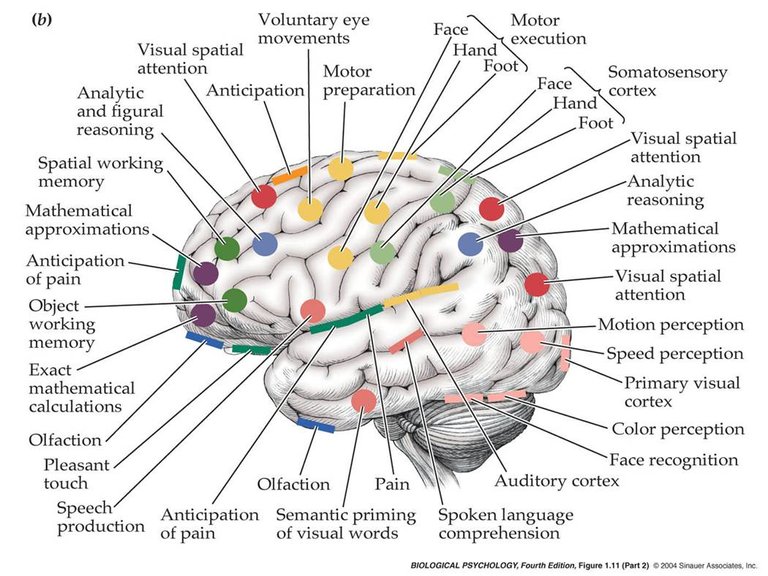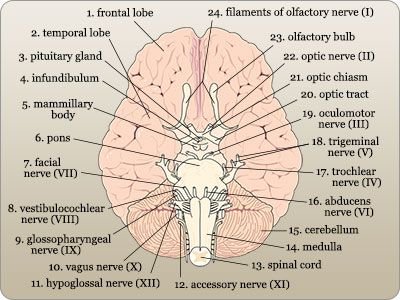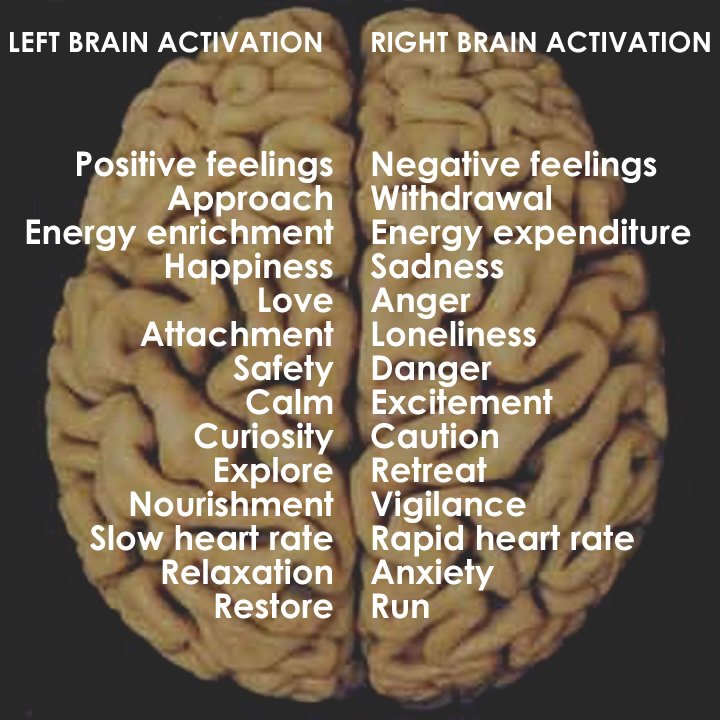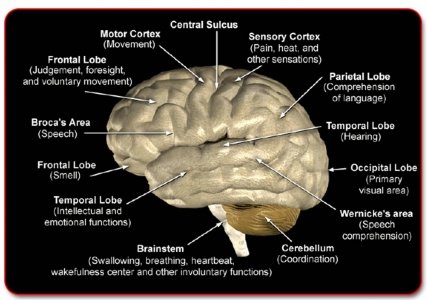The brain is, without doubt one of the most complex and extraordinary organs inside the human body. it's far made from greater than a hundred billion nerves that communicate in trillions of connections called synapses. It weighs about 3.3 lbs. (1.5 kilograms). The brain makes up about 2 percent of a human's body weight, It contains about 86 billion nerve cells (neurons) — the "gray matter".The cerebrum makes up 85 percent of the brain's weight, It contains billions of nerve fibers (axons and dendrites) — the "white matter".
Anatomy of the human brain
The biggest a part of the human brain is the cerebrum, which is split into two hemispheres. Below lies the brainstem, and behind that sits the cerebellum. The outermost layer of the cerebrum is the cerebral cortex, which includes four lobes: the frontal lobe, the parietal lobe, the temporal lobe and the occipital lobe. The human brain develops from three sections known as the forebrain, midbrain and hindbrain. Each of these contains fluid-filled cavities called ventricles. The forebrain develops into the cerebrum and underlying structures; the midbrain becomes part of the brainstem; and the hindbrain gives rise to regions of the brainstem and the cerebellum.
The cerebral cortex is substantially enlarged in human brain and is considered the seat of complicated idea. Visual processing takes place in the occipital lobe, near the back of the skull. The temporal lobe processes sound and language, and includes the hippocampus and amygdala, which play roles in memory and emotion, respectively. The parietal lobe integrates input from distinctive senses and is crucial for spatial orientation and navigation.
 image source: http://3.bp.blogspot.com/-IQIs51KP6B4/Uji1uX7AIRI/AAAAAAAABI8/NUrac1BCA2o/s1600/areas+of+memory
image source: http://3.bp.blogspot.com/-IQIs51KP6B4/Uji1uX7AIRI/AAAAAAAABI8/NUrac1BCA2o/s1600/areas+of+memory
Between the cerebrum and brainstem lie the thalamus and hypothalamus. The thalamus relays sensory and motor signals to the cortex and is involved in regulating consciousness, sleep and alertness. The hypothalamus connects the nervous system to the endocrine system — where hormones are produced — via the pituitary gland.
The cerebellum lies beneath the cerebrum and has important functions in motor control. It plays a role in coordination and balance, and may also have some cognitive functions.
THE BRAIN STEM
The brain stem is one of the most basic regions of the human brain, yet it is without doubt one of the most important areas for our physical survival. It varieties the connection between the brain and the spinal cord, maintains important control of the heart and lungs, and coordinates many important reflexes.
Vagus nerve
The vagus nerve, identified as cranial nerve X, originates in the area between the pons at the base of the brain stem and the spinal column, and extends down through the neck into the chest and abdomen. The vagus nerve includes both sensory and motor nerves and, although they contain both voluntary and involuntary branches, the involuntary members predominate.
 image source:https://s-media-cache-ak0.pinimg.com/originals/72/db/5e/72db5e132743fd377f794346c412609a
image source:https://s-media-cache-ak0.pinimg.com/originals/72/db/5e/72db5e132743fd377f794346c412609a
Corpus callosum
The sectioned corpus callosum has the appearance of a broad-arched band and forms the most distinguishing portions on the surface of the cerebrum. If the two hemispheres could be observed when they are still interconnected, the corpus callosum is on the floor of the longitudinal cerebral fissure. It consists of three divisions
- A curved front end called the genu, which tapers down gradually into a thinner portion called the rostrum. The rostrum continues down and back to join the lamina terminalis
- a thick, rounded, back end called the splenium
- a middle portion or trunk arches over the back, between the front and back extremities.
Central to the curvature of the front half of the corpus callosum can be seen the laminae of the septum pellucidum. These are two thin plates of gray and white matter that extend on each side between the corpus callosum and another curved, flattened bundle of white matter fibers, called the fornix. The function of the corpus callosum is to link the two cerebral hemispheres and allow the two sides of the brain to intercommunicate.
Inferior colliculus
The Inferior colliculus is the main midbrain nucleus and important structure of the auditory passage. It is not just a point on the way up. It is a receiver of essential information from various sources, and processing this information.
 image source:https://s-media-cache-ak0.pinimg.com/564x/7c/9a/1b/7c9a1bf62bfd5050a60b505a379c2e84
image source:https://s-media-cache-ak0.pinimg.com/564x/7c/9a/1b/7c9a1bf62bfd5050a60b505a379c2e84
The hypothalamus
The hypothalamus is the most important center for homeostasis in the human body. While it is a small region of the brain, it controls many vital bodily functions, including hunger, thirst, body temperature, and hormone secretion.
Medulla Oblongata
The medulla is easily the most important part of the brain. It's functions are involuntary, or done without thought. We would not be able to live without the medulla because of the myriad of crucial tasks it performs including regulating blood pressure and breathing. As a part of the brain stem, it also helps transfer neural messages from the brain to the spinal cord.
Pons
The pons appears as a rounded bulge on the underside of the brain stem and separates the midbrain from the enlarged continuation of the spinal cord. Several nuclei of the pons relay information from the ear, face and teeth as well as signals that move the jaw, adjust facial expressions, and produce some eye movements.
Cerebellar peduncle
A cerebellar peduncle is a nerve tract that permits communication between the cerebellum and the other parts of the central nervous system. Three pairs of cerebellar peduncles conduct this communication. The inferior peduncles bring sensory information about the actual position of body parts such as limbs and joints. The middle peduncles transmit information about the desired position of these parts. After integrating and analyzing the information from these two sources, the cerebellum sends impulses through the superior peduncles to the midbrain. In response, motor impulses are transmitted down through the pons, medulla oblongata, and spinal cord to stimulate or inhibit skeletal muscles at appropriate times and cause movements of body parts into the desired positions. This activity makes rapid and complex muscular movements possible
Left brain vs. right brain
The human brain is divided into two hemispheres, the left and right, connected by a bundle of nerve fibers called the corpus callosum. The hemispheres are strongly, though not entirely, symmetrical. The left brain controls all the muscles on the right-hand side of the body; and the right brain controls the left side. One hemisphere may be slightly dominant, as with left- or right-handedness.
 image source:http://2.bp.blogspot.com/-J7U72sJ8iPg/TpctwriCvwI/AAAAAAAAAOk/ng0TwIodYV8/s1600/wag+anatomy+11
image source:http://2.bp.blogspot.com/-J7U72sJ8iPg/TpctwriCvwI/AAAAAAAAAOk/ng0TwIodYV8/s1600/wag+anatomy+11
The popular notions about "left brain" and "right brain" qualities are generalizations that are not well supported by evidence. Still, there are some important differences between these areas. The left brain contains regions involved in speech and language (Broca's area and Wernicke's area), and is also associated with mathematical calculation and fact retrieval, Holland said. The right brain plays a role in visual and auditory processing, spatial skills and artistic ability — more instinctive or creative things, Holland said — though these functions involve both hemispheres.
Brain Conditions
Headache: There are many types of headaches; some can be serious but most are not and are generally treated with analgesics/painkillers.
Stroke (brain infarction): Blood flow and oxygen are suddenly interrupted to an area of brain tissue, which then dies. A blood clot, or bleeding in the brain, are the cause of most strokes.
Brain aneurysm: An artery in the brain develops a weak area that swells, balloon-like. A brain aneurysm rupture can causes a stroke.
Subdural hematoma: Bleeding within or under the dura, the lining inside of the skull. A subdural hematoma may exert pressure on the brain, causing neurological problems.
Epidural hematoma: Bleeding between the tough tissue (dura) lining the inside of the skull and the skull itself, usually shortly after a head injury. Initial mild symptoms can progress rapidly to unconsciousness and death, if untreated.
Intracerebral hemorrhage: Any bleeding inside the brain.
Concussion: A brain injury that causes a temporary disturbance in brain function. Traumatic head injuries cause most concussions.
Cerebral edema: Swelling of the brain tissue in response to injury or electrolyte imbalances.
Brain tumor: Any abnormal tissue growth inside the brain. Whether malignant (cancer) or benign, brain tumors usually cause problems by the pressure they exert on the normal brain.
Glioblastoma: An aggressive, malignant brain tumor (cancer). Brain glioblastomas progress rapidly and are very difficult to cure.
 image source:http://studydroid.com/imageCards/0c/s1/card-13501695-back
image source:http://studydroid.com/imageCards/0c/s1/card-13501695-back
Hydrocephalus: An abnormally increased amount of cerebrospinal (brain) fluid inside the skull. Usually this is because the fluid is not circulating properly.
Normal pressure hydrocephalus: A form of hydrocephalus that often causes problems walking, along with dementia and urinary incontinence. Pressures inside the brain remain normal, despite the increased fluid.
Meningitis: Inflammation of the lining around the brain or spinal cord, usually from infection. Stiff neck, neck pain, headache, fever, and sleepiness are common symptoms.
Encephalitis: Inflammation of the brain tissue, usually from infection with a virus. Fever, headache, and confusion are common symptoms.
Traumatic brain injury: Permanent brain damage from a traumatic head injury. Obvious mental impairment, or more subtle personality and mood changes can occur.
Parkinson's disease: Nerves in a central area of the brain degenerate slowly, causing problems with movement and coordination. A tremor of the hands is a common early sign.
Huntington's disease: An inherited nerve disorder that affects the brain. Dementia and difficulty controlling movements (chorea) are its symptoms.
Epilepsy: The tendency to have seizures. Head injuries and strokes may cause epilepsy, but usually no cause is identified.
Dementia: A decline in cognitive function resulting from death or malfunction of nerve cells in the brain. Conditions in which nerves in the brain degenerate, as well as alcohol abuse and strokes, can cause dementia.
Alzheimer’s disease: For unclear reasons, nerves in certain brain areas degenerate, causing progressive dementia. Alzheimer’s disease is the most common form of dementia.
Brain abscess: A pocket of infection in the brain, usually by bacteria. Antibiotics and surgical drainage of the area are often necessary.
